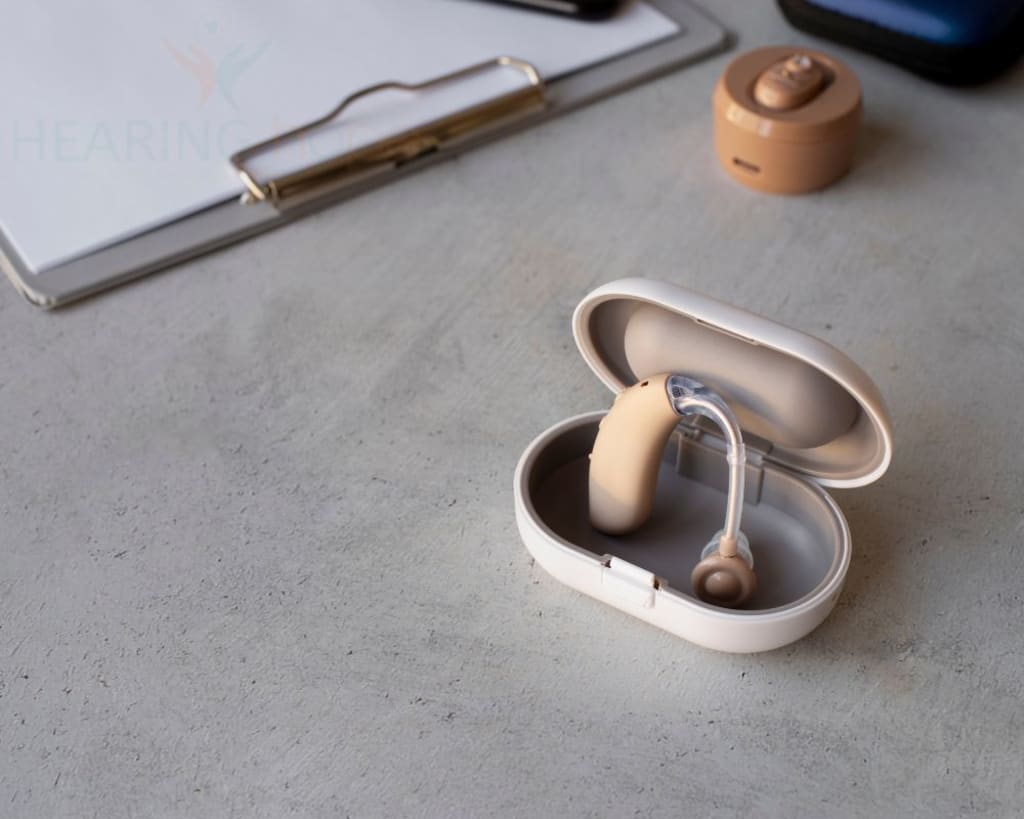The Comprehensive Guide to RIC Hearing Aids
RIC Hearing Aids

Hearing loss can significantly impact a person's quality of life, affecting communication, social interactions, and overall well-being. Fortunately, modern hearing aid technology has made significant strides in providing effective solutions. One of the most popular and advanced types of hearing aids available today is the Receiver-in-Canal (RIC) hearing aid. This comprehensive guide will delve into the world of RIC hearing aids, exploring their features, benefits, and how they compare to other hearing aid types.
Understanding RIC Hearing Aids
What Are RIC Hearing Aids?
RIC hearing aids, also known as Receiver-in-Canal or Receiver-in-the-Ear (RITE) hearing aids, are a type of behind-the-ear (BTE) hearing aid. Unlike traditional BTE hearing aids, where the speaker (receiver) is housed in the main body of the device, RIC hearing aids have the receiver located in the ear canal, connected to the main body by a thin wire. This design allows for a more discreet and comfortable fit.
How Do RIC Hearing Aids Work?
RIC hearing aids work by amplifying sound and delivering it directly into the ear canal. Here is a step-by-step process of how they function:
Sound Collection: The microphone, located in the main body of the hearing aid behind the ear, picks up sound from the environment.
Sound Processing: The sound is processed and amplified by the hearing aid's digital processor.
Sound Transmission: The processed sound is sent through a thin wire to the receiver, which is located in the ear canal.
Sound Delivery: The receiver delivers the amplified sound directly into the ear canal, providing clear and natural sound quality.
Advantages of RIC Hearing Aids
Discreet and Comfortable Design
One of the most significant advantages of RIC hearing aids is their discreet and comfortable design. The small size and placement of the receiver in the ear canal make them less noticeable than traditional BTE hearing aids. Additionally, the lightweight and ergonomic design ensures a comfortable fit, even for extended periods.
Natural Sound Quality
RIC hearing aids are known for their superior sound quality. The placement of the receiver in the ear canal allows for more natural sound delivery, closely mimicking the way sound is heard naturally. This results in clearer and more accurate sound reproduction, which is particularly beneficial in noisy environments.
Versatility and Customization
RIC hearing aids offer a high level of versatility and customization. They are suitable for a wide range of hearing loss levels, from mild to severe. Additionally, they come with various features and settings that can be adjusted to meet individual hearing needs and preferences.
Feedback Reduction
Feedback, often experienced as a whistling sound, is a common issue with many hearing aids. RIC hearing aids, due to the separation of the microphone and receiver, significantly reduce the likelihood of feedback. This ensures a more comfortable and uninterrupted hearing experience.
Features of Modern RIC Hearing Aids
Advanced Sound Processing
Modern RIC hearing aids are equipped with advanced sound processing technology. This includes features like directional microphones, noise reduction, and speech enhancement, all of which contribute to better sound clarity and understanding in different listening environments.
Connectivity Options
RIC hearing aids often come with various connectivity options, allowing users to connect their hearing aids to smartphones, televisions, and other devices via Bluetooth. This enables direct streaming of phone calls, music, and other audio, enhancing the overall hearing experience.
Rechargeable Batteries
Many RIC hearing aids now come with rechargeable batteries, offering convenience and cost savings over traditional disposable batteries. Rechargeable hearing aids typically provide a full day of use on a single charge and can be easily recharged overnight.
Tinnitus Masking
For individuals who suffer from tinnitus (ringing in the ears), many RIC hearing aids offer tinnitus masking features. These features provide soothing sounds or white noise to help mask the tinnitus, providing relief and improving overall comfort.
Smartphone Apps
Modern RIC hearing aids often come with companion smartphone apps that allow users to control and customize their hearing aids. These apps provide access to settings like volume control, program selection, and personalized sound adjustments, making it easier for users to manage their hearing aids.
Comparing RIC Hearing Aids with Other Types
RIC vs. BTE Hearing Aids
While both RIC and BTE hearing aids are worn behind the ear, there are some key differences:
Size and Discreteness: RIC hearing aids are generally smaller and less noticeable than BTE hearing aids, making them more discreet.
Sound Quality: RIC hearing aids offer more natural sound quality due to the placement of the receiver in the ear canal.
Feedback Reduction: RIC hearing aids are less prone to feedback compared to BTE hearing aids.
RIC vs. In-the-Ear (ITE) Hearing Aids
ITE hearing aids are custom-made to fit entirely within the outer ear. When compared to RIC hearing aids:
Visibility: ITE hearing aids are more visible than RIC hearing aids, which are more discreet.
Comfort: RIC hearing aids are generally more comfortable for extended wear due to their lightweight design.
Sound Quality: RIC hearing aids often provide better sound quality due to their advanced technology and receiver placement.
Choosing the Right RIC Hearing Aid
Assessing Your Hearing Needs
Before choosing a RIC hearing aid, it is essential to assess your hearing needs. This includes understanding the degree and type of hearing loss you have, as well as your lifestyle and specific listening environments. A hearing care professional can conduct a thorough hearing assessment to determine the best hearing aid for your needs.
Budget Considerations
RIC hearing aids come in a wide range of prices, depending on the features and technology they offer. It is important to consider your budget and find a hearing aid that provides the best value for your investment. While advanced features may come at a higher cost, they can significantly enhance your hearing experience.
Trying Before Buying
Many hearing care providers offer trial periods for hearing aids, allowing you to test the devices before making a final decision. This trial period can help you determine if the RIC hearing aid meets your needs and provides the desired level of comfort and sound quality.
Professional Fitting and Adjustments
Proper fitting and adjustments are crucial for optimal performance and comfort of RIC hearing aids. A hearing care professional can ensure that your hearing aids are correctly fitted and programmed to match your hearing needs. Regular follow-up appointments are also important to make any necessary adjustments and ensure continued satisfaction.
Maintaining Your RIC Hearing Aids
Regular Cleaning
Regular cleaning is essential to keep your RIC hearing aids in good working condition. This includes cleaning the microphone, receiver, and ear tips to remove any debris or earwax that can affect performance. Many RIC hearing aids come with cleaning tools and instructions to help you maintain them properly.
Battery Care
If your RIC hearing aids use disposable batteries, it is important to replace them regularly to ensure consistent performance. For rechargeable hearing aids, follow the manufacturer's instructions for charging and battery care to maximize battery life.
Protecting from Moisture and Damage
RIC hearing aids should be protected from moisture and physical damage. Avoid exposing them to water, humidity, and extreme temperatures. Store them in a protective case when not in use, and handle them with care to prevent any damage to the delicate components.
Regular Check-Ups
Regular check-ups with your hearing care professional are important to ensure that your RIC hearing aids continue to function optimally. These check-ups can include cleaning, adjustments, and any necessary repairs to keep your hearing aids in top condition.
Conclusion
RIC hearing aids offer a range of benefits, including discreet design, natural sound quality, and advanced features, making them a popular choice for many individuals with hearing loss. By understanding the features and advantages of RIC hearing aids, you can make an informed decision and choose the best hearing aid to meet your needs. Remember to consult with a hearing care professional for personalized advice and fitting, and follow proper maintenance practices to ensure the longevity and performance of your RIC hearing aids. With the right hearing aid, you can significantly improve your hearing experience and enhance your overall quality of life.
About the Creator
Hearing Hope
Our mission is to improve the health of our community by providing high quality, comprehensive hearing care in a welcoming and compassionate environment.
Enjoyed the story? Support the Creator.
Subscribe for free to receive all their stories in your feed. You could also pledge your support or give them a one-off tip, letting them know you appreciate their work.






Comments
There are no comments for this story
Be the first to respond and start the conversation.